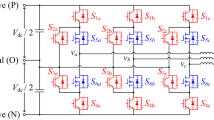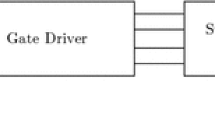Abstract
In CMOS inverters, the main part of the power supply is spent on charging the parasitic capacitance of the transistor gates and the load capacitance. Associated with this portion of energy is dynamic power consumption, which has two components—transient power consumption and capacitive-load power consumption. When the logic states of the inverter change in a short period of time, when the PMOS and NMOS transistors are switched simultaneously, a short-circuit current flows. Power losses from short-circuit current are only a small part of dynamic power consumption. For this reason, more attention is paid to reducing transient power consumption and capacitive-load power consumption. However, with the reduction in the size of the inverter transistors and the lowering of their threshold voltage, the short-circuit power losses must also be taken into account. Also, when the size of inverter transistors increases in powerful output buffers, the short-circuit current increases, which, in addition to increasing short-circuit power losses, can cause errors in the output logic. Therefore, the purpose of this work is to reduce short-circuit current and dynamic power consumption of the CMOS inverter. For this purpose, it is proposed to limit the short-circuit current by changing the state of additional PMOS and NMOS transistors included in the path of the short-circuit current. The state of additional transistors is changed by an additional clock signal with a special wave-form during the rising and falling edges of the main clock signal.










Similar content being viewed by others
Data availability
Not applicable.
References
Abdalla Y (2012) Reduction of short circuit current in static CMOS inverters using novel smart delay generator circuits. Elektrotech Inftech 129:83–87. https://doi.org/10.1007/s00502-012-0079-z
Bisduonis L (2010) Short-circuit energy dissipation model for sub-100 nm CMOS buffers. 17th IEEE Int Conf on Electronics, Circuits and Systems (ICECS), pp. 615–618
Chabini N, Chabini I, Aboulhamid EM, Savaria Y (2003) Methods for minimizing dynamic power consumption in synchronous designs with multiple supply voltages. IEEE Trans Comput Aided Des Integr Circuits Syst. https://doi.org/10.1109/TCAD.2002.807894
Donno M, Ivaldi A, Benini L, Macii E (2003) Clock-tree power optimization based on RTL clock-gating. Proceedings of the 40th Annual Design Automation Conference. Anaheim CA USA: Association for Computing Machinery (ACM), pp. 622–627. https://doi.org/10.1145/775832.775989
Guo J, Ge H, Ye J, Emadi A. (2015) Improved method for MOSFET voltage rise-time and fall-time estimation in inverter switching loss calculation. IEEE Transportation Electrification Conference and Expo (ITEC), pp. 1–6. https://doi.org/10.1109/ITEC.2015.7165790
Hanchate N, Ranganathan N (2004) Lector: A technique for leakage reduction in CMOS circuits. IEEE Transactions on Very Large Scale Integration (VLSI) Systems 12(2):196–205. https://doi.org/10.1109/TVLSI.2003.821547
Kogut I, Druzhinin A, Holota V (2011) 3D SOI elements for system-on-chip applications. Adv Mater Res 276:137–144. https://doi.org/10.4028/www.scientific.net/AMR.276.137
Kumar P, Pradeep SR, Pratibha SR (2013) LSSR: LECTOR Stacked State Retention Technique a novel leakage reduction and state retention technique in low power VLSI design”. IJERT 2:1–4. https://doi.org/10.17577/IJERTV2IS100755
Mallaraddi M, Rajani H (2018) Circuit level leakage minimization techniques in CMOS VLSI Circuits: Literature Review. IJRASET, 6(II):1526–1537
Nigam K, Tiwari A (2012) Zigzag Keepers: A new approach for low power CMOS Circuit. IJRASER 1(9):694–699
Srikanth K, Dhireesha K D (2008) GALEOR: Leakage reduction for CMOS circuits. IEEE 15th IEEE International Conference on Electronics, Circuits and Systems. https://doi.org/10.1109/ICECS.2008.4674918
Tonk A, Goyal S (2015) A literature review on leakage and power reduction techniques in CMOS VLSI design. IJRITCC 3(2):554–558. https://doi.org/10.17762/ijritcc2321-8169.150228
Veendrick H (1984) Short-circuit dissipation of static CMOS circuitry and its impact on the design of buffer circuits. IEEE J. Solid State Circuits, vol. SC-19, pp. 468–473
Weissel A, Bellosa F (2002) Process cruise control: Event-driven clock scaling for dynamic power management. Proceedings of the International Conference on Compilers, Architecture, and Synthesis for Embedded Systems. Grenoble, France: Association for Computing Machinery (ACM), pp. 238–246. https://doi.org/10.1145/581630.581668
Yoo C (2000) A CMOS buffer without short-circuit power consumption. IEEE Transactions on Circuits and Systems Ii: Analog and Digital Signal Processing 47:935–937. https://doi.org/10.1109/82.868462
Zitong H (2021) The power-delay product and its implication to CMOS Invertrer. ISPECE 2020, J Phys Confer Series https://doi.org/10.1088/1742-6596/1754/1/012131
Funding
No funding was received.
Author information
Authors and Affiliations
Contributions
All authors contributed to the study conception and design. AD and IK provided the technical support and conceptual advice. VH and TB conducted the experiments and performed simulation studies. SN and YK analyzed the results of simulation studies and drafted the manuscript. All authors read and approved the final manuscript.
Corresponding author
Ethics declarations
Conflict of interest
Authors declare that they have no conflict of interest.
Ethical statement
This study has nothing to do with human participants or health-related outcomes.
Additional information
Publisher's Note
Springer Nature remains neutral with regard to jurisdictional claims in published maps and institutional affiliations.
Rights and permissions
Springer Nature or its licensor (e.g. a society or other partner) holds exclusive rights to this article under a publishing agreement with the author(s) or other rightsholder(s); author self-archiving of the accepted manuscript version of this article is solely governed by the terms of such publishing agreement and applicable law.
About this article
Cite this article
Druzhinin, A., Kogut, I., Holota, V. et al. The method of reducing the CMOS inverter switching energy. Appl Nanosci 13, 7501–7511 (2023). https://doi.org/10.1007/s13204-023-02929-9
Received:
Accepted:
Published:
Issue Date:
DOI: https://doi.org/10.1007/s13204-023-02929-9




